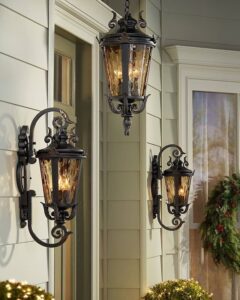
Industrial outdoor lighting serves a purpose far beyond mere visibility; it is a critical investment in a property’s security, operational efficiency, and overall durability. Designed to withstand harsh weather conditions and heavy use, these lighting systems are built for functionality and longevity. They include a wide range of fixtures such as powerful floodlights that illuminate large areas, rugged wall packs that provide concentrated light on a building’s perimeter, and sturdy post lights that line pathways and parking lots. The primary function of these lights is to ensure safety for both employees and visitors, reducing the risk of accidents by eliminating dark, shadowy areas.
The strategic placement of industrial outdoor lighting is a powerful deterrent to crime. A well-lit exterior makes a property less appealing to intruders and provides security cameras with clear, high-quality footage. In an industrial or commercial setting, this level of security is non-negotiable. Furthermore, modern industrial lighting, particularly LED solutions, offers significant operational benefits. LED fixtures are highly energy-efficient, consuming a fraction of the power of older technologies, which leads to substantial savings on utility bills. They also have an exceptionally long lifespan, reducing the need for frequent maintenance and costly bulb replacements. By providing reliable illumination for loading docks, walkways, and parking areas, these systems extend a property’s hours of safe operation, supporting productivity and peace of mind around the clock.
The Versatility and Style of Indoor Lighting Fixtures
While industrial outdoor lighting is about function and durability, the world of indoor lighting fixtures is a blend of practicality and design. Inside a building, lighting takes on a more nuanced role, shaping the mood, highlighting architectural features, and providing the precise illumination needed for specific tasks. There are three main categories of indoor lighting, each with a distinct purpose: ambient, task, and accent lighting.
Ambient lighting provides the overall illumination for a room, creating a comfortable and uniform brightness. This can be achieved with a variety of fixtures, such as elegant chandeliers in a lobby, recessed lights that create a clean, modern look, or flush-mount ceiling lights for a simple, effective solution in hallways and offices. Task lighting, on the other hand, is focused on illuminating a specific area for a particular purpose. This includes under-cabinet lighting in a kitchen for meal preparation, a desk lamp in an office for reading and writing, or pendants hanging over a conference table. These fixtures are designed to reduce eye strain and improve productivity by providing direct, focused light where it is most needed. Finally, accent lighting is used to draw attention to specific features, such as a piece of art, a plant, or an architectural detail. This is often accomplished with track lighting, wall sconces, or spotlights that create a dramatic and sophisticated effect. The wide variety of indoor lighting fixtures available allows for an endless array of design possibilities, enabling designers to create spaces that are not only functional but also visually stunning and inviting.
Creating Cohesion: Marrying Indoor and Outdoor Lighting
A truly exceptional property is one where the design flows seamlessly from the interior to the exterior. This sense of continuity is often achieved through a cohesive lighting strategy that marries indoor lighting fixtures with industrial outdoor lighting. The goal is to create a harmonious visual experience, where the lighting transitions gracefully and purposefully as one moves through the property. This can be done by using similar lighting styles, color temperatures, or design elements. For example, a business that uses sleek, modern fixtures indoors can extend this aesthetic to the outside with contemporary post lights and wall packs.
Furthermore, a well-planned lighting system can be used to connect indoor and outdoor spaces, blurring the lines between them. For a restaurant with a patio, a combination of stylish indoor pendant lights and complementary outdoor string lights can create a unified and inviting atmosphere. Similarly, large windows and glass doors can become a feature at night when the interior lighting is designed to illuminate the space and reflect the lighting from the exterior. This thoughtful integration enhances the overall design, creates a sense of spaciousness, and extends the usability of a property. Ultimately, a holistic approach to lighting ensures that the property is not only safe and functional in all areas but also presents a unified, professional, and sophisticated image.
The Future of Lighting: Sustainability and Smart Technology
As technology continues to advance, the world of lighting is becoming more sustainable and intelligent. The widespread adoption of LED technology has been a game-changer for both indoor lighting fixtures and industrial outdoor lighting, offering unprecedented energy savings and longevity. But the future holds even more promise. Smart lighting systems, which can be controlled remotely and programmed to adjust brightness and color temperature, are becoming increasingly common. These systems can be used to create dynamic lighting schemes, from automated security lighting that responds to motion to interior lighting that changes to match the time of day. This level of control not only improves efficiency but also enhances the user experience, providing a tailored lighting solution for every situation. For large properties, this can mean massive energy savings and a level of control that was previously unimaginable.
Conclusion:
In conclusion, the strategic use of lighting is a crucial component of modern property design and management. The powerful, durable, and energy-efficient systems of industrial outdoor lighting provide the foundational security and visibility that every business needs, protecting assets and ensuring safety around the clock. At the same time, the innovative and practical nature of a light socket electrical outlet provides an unparalleled degree of flexibility and convenience, offering a quick and easy solution for a variety of temporary power needs. By viewing these two elements not as separate tools, but as synergistic components of a holistic electrical strategy, property managers can create an environment that is not only safe and secure but also adaptable, aesthetically pleasing, and prepared to meet the demands of a dynamic business world.






